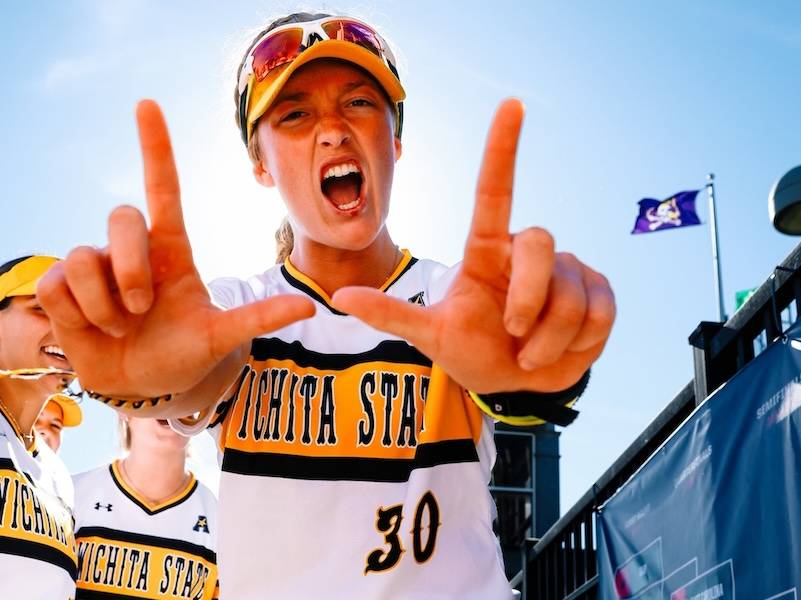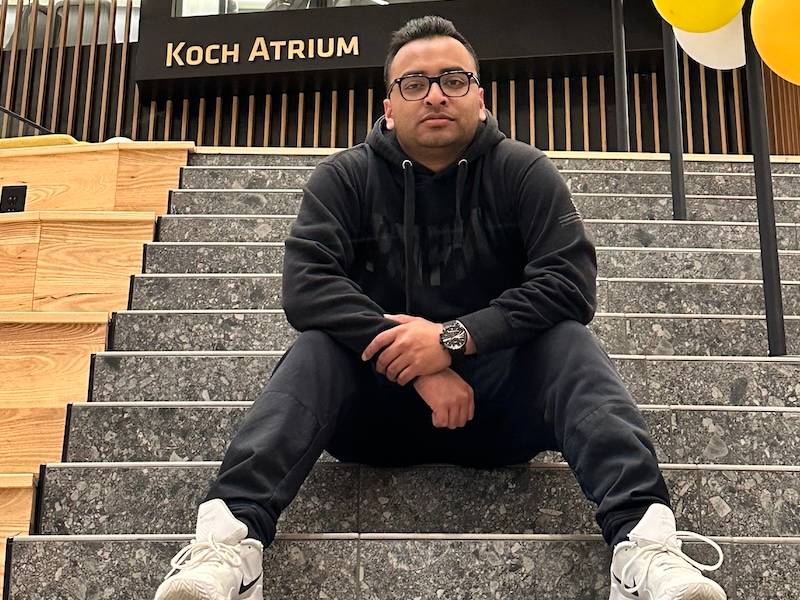When Alissa Haddock joined the ┬ķČ╣ŲŲĮŌ░µ State University Strategic Communications team as an intern in spring 2022, it was abundantly clear that she possessed outstanding talent as a graphic artist. What wasnŌĆÖt as apparent was her lifelong battle with her health.
A few months into her internship, her outward fa├¦ade started to reflect her internal health struggles: Her skin and eyes took on a yellow hue, and her demeanor and the dark circles under her eyes suggested that she was someone who was just bone tired.
Today, as she creates and collaborates from her desk in Morrison Hall, she is positively glowing inside and out with renewed vigor and enthusiasm ŌĆö not just for her job, but for life ŌĆö all because of a new liver, thanks to her cousinŌĆÖs selfless donation.
An uncertain start
At just six weeks old, Alissa was diagnosed with AlagilleŌĆÖs Syndrome ŌĆö a genetic disorder that affects the liver by causing a reduction in the number of bile ducts, which can lead to liver damage and impaired liver function.
ŌĆ£She was very jaundiced, and her eyes were yellow, her stools were white, and she itched a lot,ŌĆØ said AlissaŌĆÖs mother, Susan Haddock. ŌĆ£There was a lot of uncertainty about whether she would survive the disease. One doctor indicated that there was nothing they could do for her and be prepared for possible death.ŌĆØ
During surgery, doctors found that her liver was green, and her bile ducts werenŌĆÖt functioning correctly. The doctor flushed out her liver and gall bladder and got her tiny body working again. But living with AlagilleŌĆÖs Syndrome, she was on a clock.
ŌĆ£The liver disease caused me to itch when I was really little,ŌĆØ said Alissa, a senior in graphic design. ŌĆ£It would itch so bad that I would have sores all over myself.ŌĆØ
Her family worked as a team to make life as normal as possible for Alissa despite the difficult circumstances.
ŌĆ£We used humor to overcome the obstacles,ŌĆØ Susan said. ŌĆ£As parents, we were always in awe by her resilience. She very rarely complains, even when she is uncomfortable or hurting. We talk, laugh and deal with her problems. We just deal with whatŌĆÖs in front of us and carry on.ŌĆØ
Over the years, there were dietary adjustments (including expensive baby formula), a handful of medications every day, and many trips to ChildrenŌĆÖs Mercy Hospital in Kansas City. As she grew, Susan said it became apparent that she was very small for her age, and she needed growth hormones for several years to boost her growth.
ŌĆ£In growing up with the disease, what was normal to Alissa was a far cry from her friends,ŌĆØ Susan said. ŌĆ£She had to deal with looking several years younger than her friends, while often she was the oldest. She had to deal with eating properly, the itching, administering her own medication, and a constant lack of sleep. As her disease progressed, she also had swelling, food restrictions and a feeling of nausea.ŌĆØ
At 10 years old, she started to develop cirrhosis, and at 22 ŌĆ£her liver was about destroyed,ŌĆØ Susan said.
The constant health issues took a toll on AlissaŌĆÖs mental health, too.
ŌĆ£I really felt like I just couldn't feel like I could do much with my life with all my liver problems. I just felt like I couldnŌĆÖt move on to the next steps,ŌĆØ she said. ŌĆ£I was very aware about how I was feeling, so I would look for any kind of symptom that could possibly mean liver failure. I was a little paranoid.ŌĆØ
Family to the rescue
Despite being spread across the country, AlissaŌĆÖs extended family is close ŌĆö a bond thatŌĆÖs reinforced every summer when dozens of relatives from her momŌĆÖs side rent cabins at the Lake of the Ozarks for a reunion. ItŌĆÖs a tradition the family has continued for the past 18 years.
Over the years, the family has kept up to date on the latest news about AlissaŌĆÖs health and liver function.
ŌĆ£She was born with this disease, and we all knew it,ŌĆØ said Michelle Delaney, AlissaŌĆÖs cousin, who lives in Drake, Colorado. ŌĆ£The first goal was to get her through childhood without needing a liver transplant. She made it through that. Then we wanted to get her through puberty without a liver transplant. She made it through that. Then this last summer, we knew she was going to the Mayo Clinic.ŌĆØ
Despite evidence that relatives are often the best matches for an organ transplant, Alissa and Susan never wanted to burden the family. But the cousins had their own ideas.
ŌĆ£Last summer at our family reunion, we were all kind of talking about it. It was kind of a ŌĆśWho's the best candidate?ŌĆÖ conversation,ŌĆØ Michelle said. ŌĆ£We were joking and competitive about it.ŌĆØ
The cousins started discussing their individual situations, circumstances and qualifications; and it quickly narrowed the candidate pool to one person: Michelle.
ŌĆ£My situation was just lining up the best. I'm done having kids. My job was very flexible. I was going to be able to take some downtime, and the time of year worked best for me,ŌĆØ Michelle said. ŌĆ£I never really had a second guess about it. It just felt right.ŌĆØ
The transplant

Alissa and Michelle visit in the hospital after the transplant.
On Dec. 15, 2022, at the Mayo Clinic in Rochester, Minnesota, Michelle had 67.2% of her liver ŌĆö her entire right lobe ŌĆö transplanted into Alissa.
ŌĆ£They took my entire right lobe, and then the left lobe grows in to replace it,ŌĆØ she said. ŌĆ£So technically I can never donate a liver again because I no longer have a right lobe. It's just one big left lobe.ŌĆØ
Susan said the initial results after the surgery were great and Alissa seemed well on the way to a quick recovery, but the family was warned that there could be complications.

Alissa rests in a chair soon after the transplant surgery.
ŌĆ£I woke up with an incision in my stomach and it was really tough at first because I was in pain; and I had drainage tubes, which are these big bulky things you have to carry around. It was hard at first,ŌĆØ Alissa said.
The family stayed at a vacation rental near the hospital so Alissa could continue her healing journey and they could be near the Mayo Clinic if there were any issues.
About three days later, Alissa developed a leaky artery and began to bleed internally.
ŌĆ£This was very scary because we were watching her become weaker and weaker,ŌĆØ Susan said.
There was another surgery to repair the leak and another point where her spleen had complications. But then things settled.
Back to life
In January, Alissa returned to her home in Derby to continue her healing journey. Her prognosis is optimistic, sheŌĆÖs moving forward with a new energy, and sheŌĆÖs discovered at least one unexpected side effect of the surgery.
ŌĆ£Before the surgery, I had a really huge spleen,ŌĆØ she said. ŌĆ£It would put pressure on my stomach, and I wouldn't be able to sleep on my stomach because I'd have this big bulky spleen.ŌĆØ
ItŌĆÖs not uncommon for patients with chronic liver disease to also suffer from spleen inflammation due to pressure build-up in the blood vessels that run through the liver and spleen.
ŌĆ£So, after the liver transplant, when I healed some more, I was able to like to lay on my stomach, and I yelled to my mom, ŌĆśI can lay on my stomach!ŌĆØ she said. ŌĆ£I was never able to do that before.ŌĆØ
As for Michelle, she returned to Colorado to her 3- and 5-year-old sons and her career as a laboratory director for an analytical pharmaceutical testing lab. She spent six weeks recovering with the support of her husband and nearby family.
ŌĆ£I think the hardest part was because my sleep schedule got really weird. I just couldnŌĆÖt sleep at night. The liver filters a lot of hormones, so when you're lacking a lot of liver, your hormones get kind of weird,ŌĆØ she said.
SheŌĆÖs since returned to work, and all signs point to a full recovery.
ŌĆ£All my bloodwork has been fine. All my hormones are within range. My cholesterol is good. So, it's back to normal, back to life,ŌĆØ she said.
Class of 2023
Alissa is one of more than 2,200 Shockers who will be awarded a degree when she graduates from ┬ķČ╣ŲŲĮŌ░µ State on May 13. She earned a Bachelor of Fine Arts in graphic design, and sheŌĆÖs looking forward to what comes next.
She jumped right back into her classes at ┬ķČ╣ŲŲĮŌ░µ State without missing a beat. In her final semester, Alissa was determined to stick with her plan to graduate on time ŌĆö even completing her senior showcase, which was inspired by her experiences in the hospital.
ŌĆ£I was blown away with AlissaŌĆÖs company concept called Assure Wear,ŌĆØ said Amy Easum, director of Creative Services and AlissaŌĆÖs supervisor in Strategic Communications. ŌĆ£Her idea centers around providing patients with different types of hospital wear that is much more comfortable than what we find in hospital settings. I was so impressed with Alissa trying to build on her experiences to help others.ŌĆØ
In February, she returned to her job in Strategic Communications, her physical and emotional transformation was palpable. Her cheeks were rosy, and her eyes were bright and alive. She excitedly shared details about her surgery and recovery ŌĆö even sharing a picture of the damaged liver compared to the new liver.
And she continues to impress her coworkers with her creativity.
ŌĆ£Creativity comes very naturally to Alissa. SheŌĆÖs not afraid of experimenting. She creates illustrations that she brings to life with animation. If you give her a starting point, she can expand on it tenfold,ŌĆØ said Jaci Ignudo, senior digital specialist in Strategic Communications.
Alissa is hoping that her degree and her internship will translate into a career.
ŌĆ£Right now, I'm looking for a stable graphic design job so I can just get started. I think I want to go into more on the side of packaging design,ŌĆØ she said.
Easum said Alissa will be an asset wherever she goes after she leaves ┬ķČ╣ŲŲĮŌ░µ State.
ŌĆ£Of the many things that I love about Alissa is her positive outlook. She comes to work each day with such a good attitude and is always open to suggestions. She is such a joy to work with,ŌĆØ she said.
Susan said her daughterŌĆÖs concerns align with those of any other soon-to-be college graduate.
ŌĆ£As any young adult nearing the end of her college experience, Alissa is worried about her grades and finding a job. We are hoping she finds one with good insurance and a good future,ŌĆØ Susan said. ŌĆ£After that, we are hoping for as normal a life as possible. We hope that the beautiful gift of a new liver from her awesome cousin, Michelle, will last her a lifetime.ŌĆØ
About ┬ķČ╣ŲŲĮŌ░µ State University
┬ķČ╣ŲŲĮŌ░µ State University is Kansas' only urban public research university, enrolling almost 22,000 students between its main campus and WSU Tech, including students from every state in the U.S. and more than 100 countries. ┬ķČ╣ŲŲĮŌ░µ State and WSU Tech are recognized for being student centered and innovation driven.
Located in the largest city in the state with one of the highest concentrations in the United States of jobs involving science, technology, engineering and math (STEM), ┬ķČ╣ŲŲĮŌ░µ State University provides uniquely distinctive and innovative pathways of applied learning, applied research and career opportunities for all of our students.
The Innovation Campus, which is a physical extension of the ┬ķČ╣ŲŲĮŌ░µ State University main campus, is one of the nationŌĆÖs largest and fastest-growing research/innovation parks, encompassing over 120 acres and is home to a number of global companies and organizations.
For more information, follow us on Twitter at and Facebook at .






